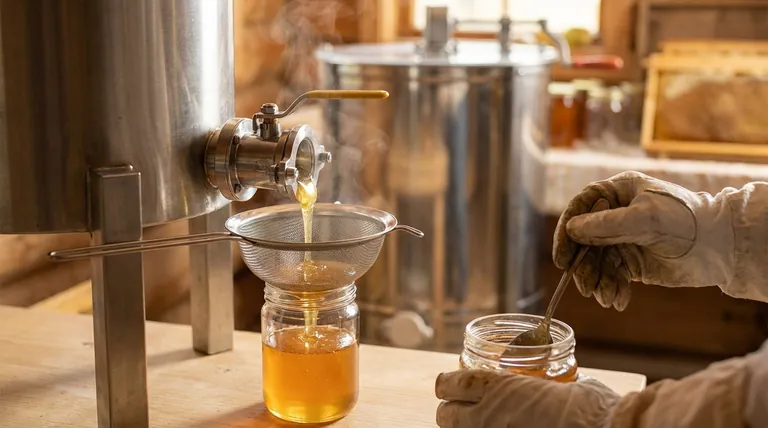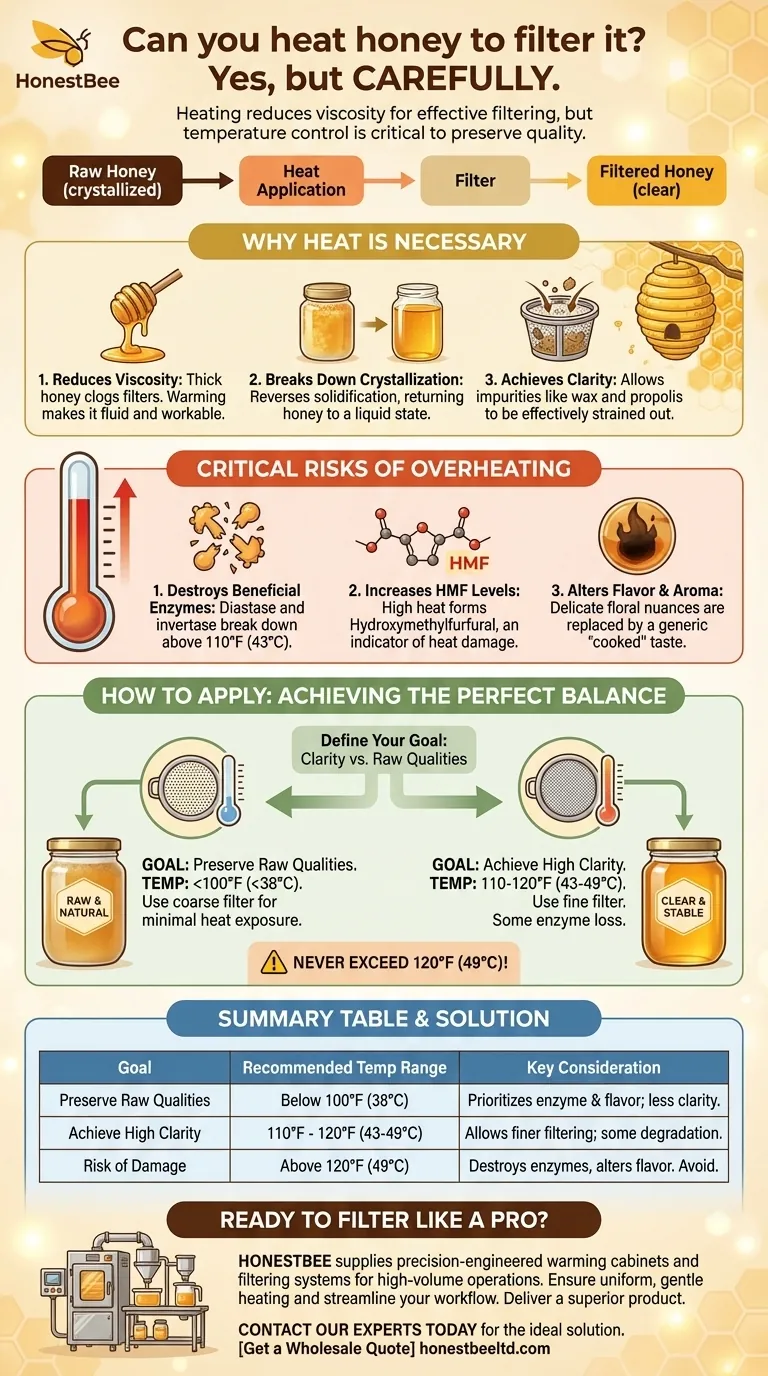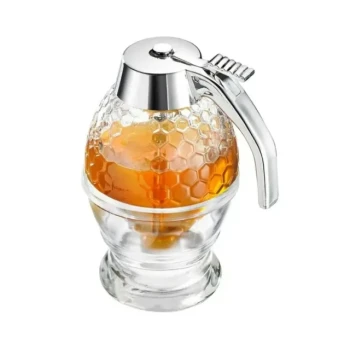Yes, heating honey is a standard and often necessary step for effective filtering. This process reduces honey's natural thickness, or viscosity, allowing it to flow more easily through a strainer or filter to remove impurities like wax, pollen, and other debris from the hive.
The central challenge is not if you should heat honey for filtering, but how. Heating is essential to make honey workable, but overheating will permanently destroy the delicate enzymes and complex flavors that define high-quality, natural honey. Your goal is to apply the minimum heat necessary to achieve your desired clarity.

Why Heat is a Necessary Tool for Honey Processing
To filter raw honey effectively, you must first address its physical state. Heat is the primary tool used to temporarily alter its properties for processing.
The Problem of Viscosity
Honey is naturally viscous, meaning it is thick and resists flowing. This thickness makes it nearly impossible for the liquid to pass through the fine mesh of a filter, trapping impurities and honey alike. Gently warming the honey makes it significantly more fluid.
Breaking Down Crystallization
Most raw honey will crystallize over time, turning from a smooth liquid into a semi-solid, granular state. Heating is the most effective way to reverse this process, melting the glucose crystals and returning the honey to its original liquid form.
The Goal: A Clear, Impurity-Free Product
Filtering removes small particles that are undesirable for the end consumer, such as bits of beeswax, propolis, and other hive debris. By reducing viscosity and liquefying crystals, heating allows these impurities to be easily strained out, resulting in a clearer and more stable final product.
The Critical Risks of Overheating
While necessary, heat is also the single biggest threat to honey's quality. Exceeding safe temperatures can cause irreversible damage, fundamentally changing the nature of the product. This is the most common mistake made during home processing.
Destroying Beneficial Enzymes
Honey contains beneficial enzymes like diastase and invertase, which are introduced by bees. These proteins are extremely sensitive to heat and begin to break down at temperatures above 110°F (43°C). Overheating effectively sterilizes the honey, removing one of its key "raw" and "natural" properties.
Increasing HMF Levels
Hydroxymethylfurfural (HMF) is a compound that forms when the sugars in honey are heated. While present in trace amounts naturally, HMF levels are a key indicator used in the industry to detect heat damage or age. High HMF levels disqualify honey from being sold as high-grade table honey in many markets.
Altering Flavor and Aroma
The delicate and unique flavor profile of any given honey comes from the specific nectar source. Overheating can caramelize the simple sugars (fructose and glucose), introducing a generic, slightly burnt or "cooked" flavor that masks the honey's original aromatic nuances.
How to Apply This to Your Project
Your approach should be dictated by your end goal for the honey. There is a direct trade-off between the clarity of the honey and the preservation of its most delicate, raw qualities.
- If your primary focus is preserving raw honey qualities: Use the absolute minimum heat required (ideally below 100°F / 38°C) just until the honey is liquid enough to pass through a coarse filter. This prioritizes enzyme and flavor preservation over perfect clarity.
- If your primary focus is creating exceptionally clear, long-lasting liquid honey: Heat the honey uniformly in a water bath to a temperature between 110°F and 120°F (43-49°C). This allows for finer filtering but will cause some degradation of heat-sensitive compounds. Never exceed this range.
By carefully managing temperature, you empower yourself to produce a beautifully filtered product while honoring the natural integrity of the honey.
Summary Table:
| Goal | Recommended Temperature Range | Key Consideration |
|---|---|---|
| Preserve Raw Qualities | Below 100°F (38°C) | Prioritizes enzyme & flavor preservation; may have less clarity. |
| Achieve High Clarity | 110°F - 120°F (43-49°C) | Allows finer filtering; some enzyme degradation occurs. |
| Risk of Damage | Above 120°F (49°C) | Destroys enzymes, increases HMF, alters flavor. Avoid. |
Ready to Filter Your Honey Like a Pro?
For commercial apiaries and distributors, achieving the perfect balance of clarity and quality is a matter of using the right equipment. HONESTBEE supplies durable, precision-engineered honey warming cabinets and filtering systems designed for high-volume operations.
- Ensure uniform, gentle heating to protect your honey's grade and value.
- Streamline your workflow with equipment built for efficiency and reliability.
- Deliver a superior product to your customers, batch after batch.
Contact our experts today to find the ideal honey processing solution for your business. ➡️ Get a Wholesale Quote
Visual Guide

Related Products
- 10L Stainless Steel Electric Honey Press Machine
- Honey Concentrating Vacuum Heating Thickening Machine Dehumidifier for Honey
- 0.5T Capacity Honey Dehumidifier Dryer with Vacuum Heating and Thickening Filtering Machine
- Honeycomb Style Drip Free Honey Dispenser
- Professional Thermostatic Conical Honey Melter
People Also Ask
- How does pressed honey compare to extracted or crush-and-strain? Unlock the Full Flavor of the Hive
- How does the press method for extracting honey work? A Simple, Low-Cost Guide for Beekeepers
- What voltage options are available for stainless steel screw honey pumps? Choose the Right Power for Your Scale
- What are the benefits of using a honey press for Warré or Top Bar beehives? Maximize Your Natural Harvest
- What are the key features of the stainless steel honey press? Maximize Yield & Guarantee Purity



















